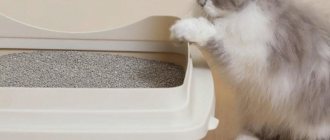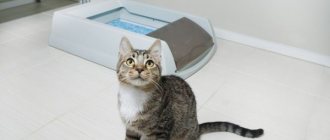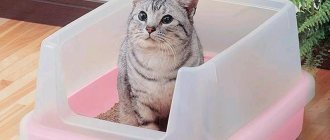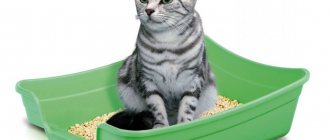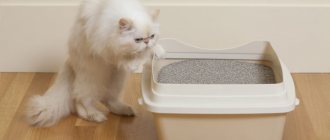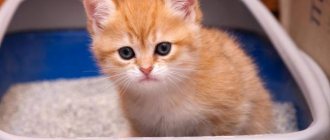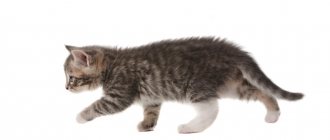The intricacies of cat litter: what do you need?
It is more natural for a cat to go into a litter tray than to relieve itself in the corners. Peeing and pooping in the sand or soil, then burying your feces and their smell is inherent in it by nature. Only a rare cat is completely unteachable.
IMPORTANT: Cats are clean animals. Typically, humans do not need to toilet train kittens. The mother cat takes this care upon herself.
If the kitten is with its mother for one and a half to two months, the mother regularly goes to the litter box herself, there is a high probability that once the baby finds itself with its new owners, it will very soon go to it. Small errors in the first days can be attributed to the stress experienced by the animal and getting used to the new environment.
A potty with filler and a spatula should appear in the house at the same time as the kitten.
Owners who decide to get a kitten, in turn, need to prepare for its appearance in the house by acquiring a “cat dowry”:
- Buy a tray. You may have to buy several trays at once. If the apartment or house is large, it is good to place them in every room, at least for the first time. Then the toilet will always be in sight of the kitten, reducing the risk that the baby will not reach it if necessary.
- Buy filler for the tray. For a kitten, it is better to take the one that is odorless. Odorous ones may neutralize the “amber” of cat urine. But! Firstly, pungent odors can scare away the animal, and it organizes a toilet for itself in the most unusual and inappropriate place. Secondly, the kitten may be allergic to the fragrance. Alternatively, you can use sand instead of filler. But where is the guarantee that it is clean? And sand does not retain odors. Also, sometimes scraps of newspapers are placed in the kitten's tray. But the paint on them can be toxic, so if you use paper, it’s better to use the simplest toilet paper.
- Buy a mat for the tray. Then there will be no traces of wet paws on the floor, and the smell will not spread throughout the apartment.
- Buy a spatula for the tray. They are sold in pet stores, but an ordinary children's sand scoop will also work.
IMPORTANT: In order for a kitten to start going to the litter box, it is important not only to choose it correctly, but also to place it in the right place
Usually, a kitten is potty trained by its mother cat.
Often owners are concerned about problems of smell and aesthetics, and they hide the tray in the apartment, for example, in the toilet. But at first the animal may not have time to reach him. The tray should be positioned so that it is accessible to the kitten, but so that no one scares the baby away during the toilet.
It is better to choose a secluded corner for him. If later you want to hide the pot, you need to do this gradually, moving it little by little every day to its destination.
IMPORTANT: The cat's potty should be as far away from his dishes as possible.
If the kitten is from a clean cat, its owner guarantees that it is toilet trained; often it is enough to show the baby his new potty a couple of times for him to start using it regularly. But there are situations when the kitten doesn’t even see the tray, peeing and pooping anywhere but in it. Then the owners have to try to correct the situation.
Why the kitten doesn't go to the litter tray: reasons
A kitten is a person who does not tolerate violence, so the following mistakes by the owner lead to abandonment of the tray:
- Punishment: the owner sees a puddle on the floor and punishes the pet. The kitten begins to perceive the owner not as the dominant individual in the pride, but as an enemy and resorts to deception: leaving piles in inaccessible places and puddles on the carpet. Fortunately, the liquid is well absorbed and traces of misconduct are invisible.
- Coercion: it’s one thing when a person notices that a pet is fussing, picks it up affectionately, and carries it to the tray. When this is done forcibly, after feeding, and held until defecation occurs, even a toilet-trained animal changes its habits and begins to shit where no one will disturb it.
- Dangers: on the way to the tray, a tormentor - a dog or a child - appears unexpectedly or expectedly. Therefore, the cat hides in a secluded place and does its business, which is not immediately detected by the smell.
- Untidy litter box: cats are clean animals, and at the same time, predatory ones. They will not sit in ambush where the smell might give them away.
- Repellent filler. Cats are capricious individualists. They may not like the smell or consistency. It's even worse if you like it. The pet will eat the pellets and become poisoned.
- Stress: renovations, rearrangement of furniture, moving, the birth of a child, the appearance of a new pet in the apartment causes the animal to mark its territory.
Be sure to read:
How to wean a cat off dry food: 4 working techniques, transferring the cat to homemade food
When a pet appears in the house, the owner must explain to the household the rules for handling the kitten.
How to potty train a 3 month old kitten? How long does it take to train?
The kitten needs a low pot so that he can climb into it without difficulty.
Until the age of five months, the kitten goes to the toilet frequently. If he is not litter box trained, a serious problem arises. The owners reproach him for being unclean and may begin to think about how to get rid of the animal. But most likely, everything will be fixed!
- You need to compare a 3 month old kitten with a human child and try to put him on the potty. It is necessary to develop a “feeding-toilet” ritual for the baby. The kitten has eaten, drank some water, and should be taken to the potty! A full stomach and bladder should do the trick.
- It is necessary to place the kitten on the tray after each sleep.
- The baby will need to be monitored. If he suddenly stops playing, sniffs, and starts “digging,” he should be moved to the potty. This should not be done abruptly, without screaming, so that the kitten does not get scared.
- A common mistake is to pick up a kitten's paw and make digging movements with it. From such violent manipulation the animal will become confused, frightened and unlikely to understand what is required of it. The best option is to take on the mother cat's job, sit next to the cat potty and scoop the litter with your palm.
- If the kitten ignores the litter box and relieves itself in the same place, it may be necessary to permanently or temporarily move the litter box there. Often such a place is the corner behind the door, the space behind the chair or behind the sofa, secluded, quiet, where the baby feels safe.
- Another option is to limit the kitten’s “habitat” so that it does not have access to the places where it organizes its toilet. But there should be no talk of locking it in the toilet or on the balcony. If a kitten makes a puddle, there is no point in poking his nose into it. He will not draw useful conclusions for himself, but he may begin to take revenge.
IMPORTANT: Places where a 3-month-old kitten goes to the toilet must be thoroughly washed so that they do not retain the smell of his feces.
If a 3-month-old kitten does not get used to going to the litter box, its habitat needs to be limited for a while.
You can read about how to remove the acrid smell of cat urine here:
The kitten is potty trained immediately, within a couple of days or until it grows up. If he went where he needed to go one, two or three times, this is not yet a system. The baby will need to be monitored for a few more days to consolidate the results.
Cats are clean pets, so the kitten very quickly learns to use the litter box.
Basic steps to train a cat to use the litter box
For many cat owners, the animal’s refusal to use the litter box becomes a significant incentive to achieve their goal. Therefore, in order to avoid these acute moments in the relationship with your pet, it is recommended to carry out a number of activities to promote mutual reconciliation and understanding.
So, when solving the problem of how to train an adult cat to use a litter box, you need to:
- Choose the right toilet location for your cat. It is advisable that this be either a heated balcony or a storage room, or a bathroom. Rooms such as the hallway and kitchen are absolutely not suitable for these purposes, since they are simply unhygienic. When choosing a place for a toilet for a cat, you must be guided by simple logic: your pet’s latrine should be hidden from prying eyes, since it is known that cats are delicate creatures and do not like special attention in this regard.
- You need to choose a comfortable rectangular tray for your now adult pet, which should be at least 10 cm deep so that the cat is more likely to recognize this container as a toilet.
- Purchase a special clumping litter at the pet store that absorbs unpleasant odors, or natural wood filler (the safest and most profitable material from a financial point of view).
The most popular is natural wood filler.
Instead of a classic cuvette tray, a special factory-type toilet house for cats can also be used and installed in a place hidden from prying eyes. It will be very convenient for an adult animal to relieve its natural need, as it will create the effect of security and intimacy of the ongoing process. In addition, if you did not have time to clean up after your cat in a timely manner, special filters installed in such a toilet house will purify the air and give your pet a feeling of cleanliness and freshness inside.
There are several signs that help the owner outline a plan of action and navigate how to accustom an adult cat to the litter box:
- Sniffing the corners and pawing the floor with its paws, as well as the cat's fussing are the first signs that the animal wants to go to the toilet. It is necessary to transfer the cat to the tray as quickly as possible, and when the procedure is completed, praise and pet the pet for correctly performed actions.
- Very often, when they are kittens, and also as they grow older, some cats immediately run to the toilet after sleeping or eating - this is another law of nature that will tell you when you need to take your pet to the litter box, in order to subsequently teach it to deal with it on its own and properly action.
The toilet house is most convenient for adult cats
Advice! If your pet stubbornly refuses to go to the litter tray, it is recommended to pay attention to the type of litter and, if necessary, change it.
How to potty train an adult cat quickly?
If you took home not a small kitten, but an adult cat from the street or from a shelter, perhaps she is already potty trained, she will only need some time to adapt. If a street animal has been going to the toilet anywhere all its life, you will have to tinker.
In principle, the algorithm is the same as with a small kitten:
- place several pots around the house
- show the animal why they are needed
- put the cat on the potty after sleep, after eating, when she starts digging and paving
A cat, like a small child, sometimes has to be put out on the potty.
IMPORTANT: If the cat lived on the street, at first it is better to pour ordinary sand into its tray instead of litter. The pet will get used to it faster
If your cat persistently pees where it shouldn’t, it is recommended to soak a piece of cloth or cotton wool in its urine and place it in the tray to transfer the smell there. Wash the crime scene itself thoroughly.
Behavioral aspect
Well, what could be easier than to explain the behavior of a cat? Unless you prove Fermat's theorem
The main psychological reasons for the uncleanliness of cats:
- Disgust: I don’t like the place where the tray is. Or its filler
- Preference: I like a certain place (oh, but the tray is not there at all!). Or a certain filler (and which one, let the owner guess for himself)
- Insufficient cleanliness of the toilet: the filler must be changed in a timely manner, and the tray must be washed. And preferably with a soap solution, and not a toxic chemical
- Intraspecific aggression: social friction between cats living in the same apartment
- Increased anxiety: stress caused by moving or renovation, the appearance of a new family member or animal, changes in noise or smell, family quarrels, a trip to the clinic, resentment towards the owner, etc. For example, the reason for walking past the potty may be the appearance of a small child in the neighbors' house. Go figure!
If a cat leaves “standard” puddles or piles in the wrong place, then this is most likely a psychological problem. If urination is frequent and in small portions, a doctor is needed. The same thing applies to “unhealthy” stools.
From personal experience. When puddles or piles are left in the “frontal area” (on the sofa, bed or just in the middle of the room) – this is generally revenge. Think about what you did wrong?
A medical cause can easily turn into a behavioral one and vice versa. Painful sensations when urinating or defecating during illness are transferred by the cat to its tray and create a persistent aversion to it, which remains even after recovery. And severe stress, in turn, can provoke some kind of disease of the genitourinary system (idiopathic cystitis, urolithiasis).
It happens that both medical and behavioral causes are present at the same time. Bingo!
How to potty train a cat without litter?
Like its distant African ancestors, the domestic cat loves to go to the toilet on something soft, then bury the feces. It wouldn't be surprising if an unfilled pot with a rough plastic lattice might deter him. But you can still teach him to relieve himself in this way by gradually reducing the amount of sand poured into the tray.
It's a cat's instinct to scoop up its own feces.
Another thing is that the smell of urine will spread throughout the house.
The cat pees past the potty: what to do?
It happens that a cat runs to the tray, but sits on the edge or raises the back of its body high, so it relieves itself past, on the floor near the potty. The reasons for this behavior may be the following:
- the cat has health problems (for example, arthritis, it hurts to sit down)
- the filler in the tray is dirty, it has not been changed for a long time
- the tray is too small for the animal
The cat may walk past the litter box if it is too small.
You can deal with this situation:
- Have the animal examined by a veterinarian.
- Maintain tray hygiene.
- Buy a more spacious tray, with high sides, or a house tray.
- Place an absorbent disposable diaper under the tray.
What to do?
- We rule out a medical cause. We go to the doctor, make a diagnosis, undergo treatment and keep our fingers crossed that this will help restore good manners to the patient.
- We exclude a behavioral cause. There are no guarantees here. Firstly, that you will find it, and, secondly, that after eliminating it, everything will return to normal. But it's worth a try.
— So, first we try to determine what the picky person doesn’t like. Here you should analyze what’s new in the apartment (new noise, new family member, new pet, etc.). And then we create a positive feeling from this new thing - for example, when there is a new sound (a child’s cry, a neighbor’s dog barking, etc.), we say affectionate words, stroke it and give a piece of treat.
- If the reason is stress (moving, renovation, owner leaving, visiting the veterinarian, ...), then time and, again, a gentle approach can help.
— If you don’t like the toilet, we try to empirically determine the desired place for it or the preferred filling. By the way, you can see about toilets and litter here, and about training a cat to use the toilet here.
— If your pet is of advanced age, he may need a tray with lower sides.
— For our part, we make the cat’s toilet as attractive as possible for her - we monitor the cleanliness of the litter box, regularly remove feces, pour the litter to the required depth, mix it in a timely manner, refresh it and change it on time. In general, we absolve ourselves of possible blame
— On the other hand, we make the “wrong place” as repulsive as possible for the cat. Anything can be used - foil, rustling paper, a plastic surface, mothballs or other chemicals, sticky film, etc. - each animal has its own horror stories. Or we simply cover the long-suffering place with heavy furniture.
— If the pet has chosen a bath or sink for itself, but for some reason we don’t like it, we leave some water there.
— If there are several animals in the house, we try to normalize their relationship. And the formula for a comfortable number of toilets is calculated as follows: number of cats + 1. Moreover, they should be in different places (taking into account the preferences and overlap of users).
- If, in your opinion, everything seems to be normal, but the cat persistently shits in the wrong place, then an integrated approach will do - negative + positive. When we manage to “catch” the scoundrel at the crime scene, we create a negative attitude towards this place - as usual, we spray water from a spray bottle or produce a noise effect (rattle, cotton). When he deigns to recover where he should, we encourage him in every possible way, preferably financially, i.e. with a treat, thereby reinforcing a positive attitude.
- Simple supervision can also work - we monitor the pet and patiently transfer it at the right moment from the wrong place to the right place. Perhaps this will convince him in the end.
- Or we simply “cut off the oxygen” - making it impossible to access the “wrong place”.
- Sometimes “confinement” also helps - while performing natural needs, the cat is locked in a small space next to its litter box, for example, in the bathroom.
— Vertical marking is also occasionally encountered. Typically, marking a territory is typical for uncastrated animals. Everything is clear here - we castrate. But what to do with already operated cats and cats? From two trays we make one vertical, placing one in the other in a vertical position.
- In addition to all of the above, we have powerful chemical weapons at our disposal, the 21st century is just around the corner. In the fight against uncleanliness we will also use it:
Pharmacology When we are dealing with changes in behavior in a cat caused by stress, calming and relaxing medications can help. The most accessible corrective products are "Cat Bayun" (herbal), "Fitex" (herbal), "Stop-stress" (in addition to herbs, contains phenibut) and the magical "Feliway", which sprays synthetic "cat" phermones into the air. happiness".
Chemicals Enzymatic preparations for cleaning dirty places and eliminating odors, decomposing excrement even at the molecular level, sprays for habituating to a place, sprays for weaning off a place - all this can be easily found in any pet store.
Food Yes, yes, there is also a veterinary diet, specially developed and recommended for stressful situations and during the period of adaptation to change.
This is Royal Canin Calm. In addition to the fact that this is a complete diet for cats, the additional ingredients it contains (peptide α-casozepine, L-tryptophan) have a regulating effect on the activity of the central nervous system, on states of arousal, sleep and appetite.
Punishment
You cannot physically punish a cat! But if you really want to, then punishment should be applied only at the moment the offense is committed, otherwise there is no point. We just let the pet know that we are very unhappy with him. For example, in a raised tone, looking into his eyes and repeating his name, we express everything we think about his behavior. At the same time, we lightly tap his forehead with our finger a couple of times. It doesn't hurt, but it's annoying. However, each owner has his own training method.
But be careful here! Punishment can cause resentment or fear in the culprit and negatively affect the attitude towards the owner. Oh, how much worse it would be for us!
My cat Zhanna Arkadyevna enjoys great respect from the human population of the apartment, since for the slightest disrespect the offender will soon have a surprise in his shoe. It’s amazing how accurately Zhannochka identifies the right shoes.
So, to summarize:
Why did the cat stop going to the litter box?
If a cat successfully went to the litter box and then began to shit, most likely she has extreme reasons for this. Contrary to popular belief, they rarely take revenge in this way.
A cat rarely shits out of revenge. Usually, she has more compelling reasons for this.
- The cat's potty is not clean enough. It must be cleaned regularly. After each trip to the toilet, remove the crumpled litter with a spatula and periodically replace the entire contents of the tray.
- The tray is washed too thoroughly. A cat may refuse to go potty after being washed with bleach or another strong-smelling detergent.
- Incorrect filler selected. You may have to try several types to find one that your cat likes. It is not advisable to change the brand of filler. If there is no way out, you need to do this gradually, mixing a small amount of new sand with the old.
- Another cat has already gone into the litter box if there are several of them in the house. For “cat people” there is a rule: the number of pots is the number of animals in the house plus one more spare.
- The potty is too close to the cat food. A clean animal will not relieve itself where it eats.
- Someone scared the cat on the potty, now he relieves himself in secluded places. You should think about buying a potty house where no one will see the cat in action.
- The cat has a disease of the urinary system. Only a veterinarian can help here.
- Due to old age or illness, the cat cannot reach the potty. It should be moved closer to the place where the helpless animal has settled. The tray should be low. Again, it is necessary to make a visit to the veterinary clinic.
- The cat is stressed. Yes, yes, a pet can experience it if they are treated poorly, if the owners quarrel among themselves, if there are often strangers in the house, if the family has moved to a new home, if they have another animal, etc., etc. Affection, sedatives prescribed by a veterinarian, and the time needed to adapt will help.
- The cat marks. Most often, adult, uncastrated cats mark their territory. Raising their tail, they direct the stream at vertical surfaces, leaving foul-smelling spots on them. Most likely, somewhere nearby there is an animal - a potential rival or a potential “bride”.
The cat stops going to the litter box if he doesn't like the smell of the litter.
Safety
When a cat relieves itself, at this moment it is as unprotected as possible, therefore, if it is uncomfortable on the tray, there is no feeling of security, it will prefer to ignore trips to its toilet. To save space, owners often place cat litter boxes in too secluded, dark places, such as niches. Or the tray is squeezed into the tight space between the bathroom washing machine and the wall.
If your pet feels uncomfortable on the tray, don’t be surprised that he will simply start to ignore it.
The cat litter box should be located so that the cat has several approaches to it, and from different sides. In addition, there should be enough space around it.
A cat shits in a flower pot: what to do?
The cat can choose a flower pot as a toilet.
Cats are famous for the fact that they can rake soil out of flower pots or, even worse, shit in them. Here are the tricks of “cat people” that help wean fluffies from such bad habits:
- isolate pots of flowers (especially poisonous ones) from the cat
- put dry citrus skins in flower pots, cats don’t like their smell
- cover the soil in pots with foil, plastic wrap, thin plastic trays, etc.
Aids
If you were unable to stop your cat from crapping in the wrong place using the suggested remedies, you should try special medications that are sold in veterinary pharmacies.
The most popular domestically produced chemicals:
- “Don’t shit! Don't tag!";
- Antigadin;
- “Shit? No!";
- Fresh. Unlearning to shit.
Among the foreign-made products, the following drugs can be noted:
- Beaphar Stop-it Cat;
- Happy Cat.
It is important to note that they must be used in strictly limited dosages in well-ventilated areas, otherwise their smell may cause discomfort in people.
You can try to neutralize the place where the animal went to the toilet using essential oils, but they are quite expensive and are not always effective. However, if you have an extra bottle lying around, it doesn’t hurt to try.
